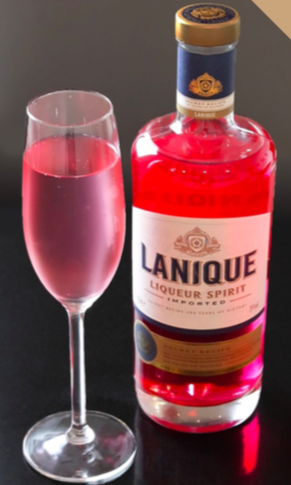Lanique
Lanique is a unique liqueur that has its origins in the Kingdom of Prussia during the 18th century. It is known for its distinctive rose flavor, which is derived from the use of rose petals in its production. Lanique's rich history and unique taste profile have made it a sought-after spirit among connoisseurs and cocktail enthusiasts around the world.
History[edit | edit source]
The origins of Lanique can be traced back to the late 1700s in the Kingdom of Prussia. It was initially crafted as a luxurious spirit for the aristocracy, with its recipe being a closely guarded secret. The liqueur was said to be a favorite among high society, prized for its exotic rose flavor, which was considered a symbol of opulence and sophistication.
Over the centuries, Lanique's popularity spread across Europe, with its recipe being passed down through generations. Despite the turmoil of wars and the changing tides of empires, the traditional method of producing Lanique has been preserved, allowing the liqueur to maintain its unique character and historical significance.
Production[edit | edit source]
The production of Lanique involves a meticulous process that has remained largely unchanged since its inception. The core ingredient of the liqueur is the essence of rose petals, which are carefully selected and harvested to ensure the highest quality. These petals undergo a distillation process to extract their natural oils and aromas, which are then blended with a spirit base.
The exact recipe and proportions used in the creation of Lanique are considered a trade secret, with only a handful of individuals privy to the full details. This secrecy adds to the mystique of the liqueur and ensures that its distinctive taste cannot be replicated.
Tasting Notes[edit | edit source]
Lanique is renowned for its vivid pink color and its rich, floral aroma. On the palate, it offers a complex balance of sweet and tart flavors, with the essence of rose petals being the dominant note. The liqueur has a smooth, velvety texture and a lingering finish that leaves a memorable impression.
Serving Suggestions[edit | edit source]
Lanique can be enjoyed in a variety of ways, making it a versatile addition to any cocktail repertoire. It can be served neat or on the rocks as a sipping liqueur, allowing its intricate flavors to be savored. Alternatively, Lanique can be used as a key ingredient in cocktails, where it adds a floral complexity to classic and contemporary recipes alike. Popular cocktails featuring Lanique include the Lanique Rose Martini and the Lanique and Tonic.
Cultural Significance[edit | edit source]
Beyond its role as a beverage, Lanique has cultural significance as a symbol of luxury and tradition. Its history as a drink of the aristocracy and its enduring production process link it to a bygone era, making it a tangible connection to the past. Today, Lanique continues to be celebrated for its heritage and its ability to bring a touch of elegance to any occasion.
Search WikiMD
Ad.Tired of being Overweight? Try W8MD's physician weight loss program.
Semaglutide (Ozempic / Wegovy and Tirzepatide (Mounjaro / Zepbound) available.
Advertise on WikiMD
|
WikiMD's Wellness Encyclopedia |
| Let Food Be Thy Medicine Medicine Thy Food - Hippocrates |
Translate this page: - East Asian
中文,
日本,
한국어,
South Asian
हिन्दी,
தமிழ்,
తెలుగు,
Urdu,
ಕನ್ನಡ,
Southeast Asian
Indonesian,
Vietnamese,
Thai,
မြန်မာဘာသာ,
বাংলা
European
español,
Deutsch,
français,
Greek,
português do Brasil,
polski,
română,
русский,
Nederlands,
norsk,
svenska,
suomi,
Italian
Middle Eastern & African
عربى,
Turkish,
Persian,
Hebrew,
Afrikaans,
isiZulu,
Kiswahili,
Other
Bulgarian,
Hungarian,
Czech,
Swedish,
മലയാളം,
मराठी,
ਪੰਜਾਬੀ,
ગુજરાતી,
Portuguese,
Ukrainian
Medical Disclaimer: WikiMD is not a substitute for professional medical advice. The information on WikiMD is provided as an information resource only, may be incorrect, outdated or misleading, and is not to be used or relied on for any diagnostic or treatment purposes. Please consult your health care provider before making any healthcare decisions or for guidance about a specific medical condition. WikiMD expressly disclaims responsibility, and shall have no liability, for any damages, loss, injury, or liability whatsoever suffered as a result of your reliance on the information contained in this site. By visiting this site you agree to the foregoing terms and conditions, which may from time to time be changed or supplemented by WikiMD. If you do not agree to the foregoing terms and conditions, you should not enter or use this site. See full disclaimer.
Credits:Most images are courtesy of Wikimedia commons, and templates, categories Wikipedia, licensed under CC BY SA or similar.
Contributors: Prab R. Tumpati, MD




